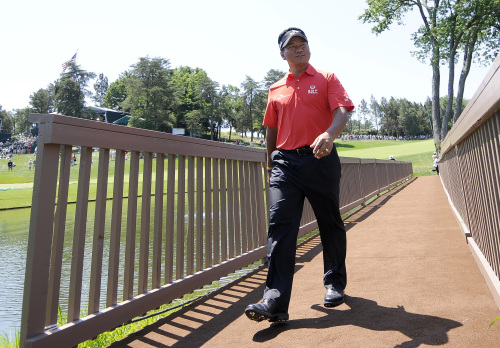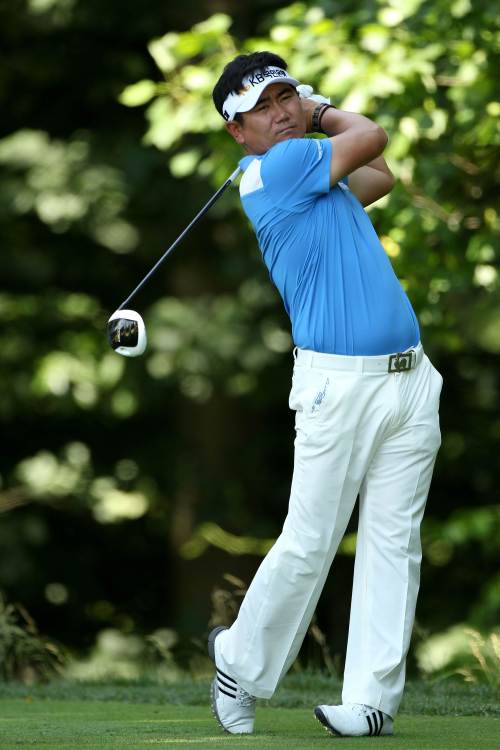BETHESDA, Maryland (AP) ― Golf’s second major championship of the year seems to have a new name.
It’s the U.S. Wide Open.
Only a small part of that is because of Tiger Woods. He’s not at Congressional because of injuries to his left leg, and he has been missing from the top of leaderboards for more than a year. This is the first U.S. Open since 1999 that Woods is not No. 1 in the world.
The top two players in the world ranking are Luke Donald and Lee Westwood, neither of whom has won a major. Parity has returned to golf so much so that 10 players have won the last 10 majors, and the last three major champions are still in their 20s.

Korea’s Choi Kyung-ju walks across the players’ bridge from the 18th green during a practice round for the U.S. Open. (AP-Yonhap News)

Korea’s Yang Yong-eun hits a shot during a practice round ahead of the U.S. Open. (AFP-Yonhap News)
But there’s another reason why the U.S. Open figures to be up for grabs when it gets under way Thursday: No one is complaining.
Jack Nicklaus, a four-time U.S. Open champion, used to listen to players gripe about the narrow fairways, thick rough and rock-hard greens and rule them out of contention. Before long, it was a short field he had to beat.
Congressional isn’t getting much criticism this week. The last several years, the USGA has been trying make the U.S. Open live up to its reputation as the “toughest test in golf” without simply making the course as hard as it could.
“If you’re complaining about playing this course,” Padraig Harrington said Wednesday, “you’re complaining that you can’t hit the shots,”
The Irishman, who has fallen out of the top 50 in the world, spent his final day of practice with Masters runner-up Adam Scott and World Golf Championship winner Nick Watney. They’re part of a field loaded with players who have won something, but no one who has won everything.
The USGA didn’t have the course exactly as it wanted because of oppressive heat the week before that kept them from cutting the green as low as usual, fearful of them dying. Even so, there already were brown patches on some of them Wednesday, and Stewart Cink couldn’t help but notice a sheen on the putting surfaces before the championship even begins.
About the only complaint from Harrington ― more subject for architectural debate ― was moving back the tee on No. 12 to make it play 471 yards. It took away the option of hitting a draw around the dogleg, and replaced it with another strong hole to start the back nine.
It was suggested to Harrington that Congressional already had ample length at the end.
“It’s an ample start,” he said. “And the middle is not that easy, either.”
Some things never change.
There was another Nicklaus comment that caught the attention of Geoff Ogilvy, who won the U.S. Open five years ago at Winged Foot.
“The U.S. Open is 72 holes of bad breaks with the occasional surprise,” Nicklaus once said.
“Which is kind of how it feels,” Ogilvy added. “It really is 72 holes of trying to not get annoyed at bad breaks. They’re the guys who do it best.”
Even so, Ogilvy has found the U.S. Open to be more about “fair” than “tough” in the five years that Mike Davis, the new executive director of the USGA, has been in charge of setting up the golf courses.
He has kept the graduated rough ― it gets deeper the farther a tee shot strays from the fairway ― and shaved some of the sides of bunkers to allow balls to roll into the sand. On some holes, particularly the par-5 16th, the sides of the greens have been turned into collection areas that will send shots into the pine needles beneath the trees. That at least allows for options in chipping.
“All I’d like them to do is come to a golf course and say, ‘How do we make this golf course find the best player this week?’ It’s getting more that way,” Ogilvy said. “It used to be, ‘How do we make this the hardest course we possibly can?”
Phil Mickelson has thrived in just about every condition at the U.S. Open, getting into the record book with five runner-up finishes. About all that’s left for him to do is win, and he’s at least inspired this week by the way the course is set up.
As for not having Woods around?
“I’ve always felt as though Tiger has helped bring out some of my best golf over the years,” Mickelson said. “And even though my record against him may not be the best, it’s helped me achieve a higher level that I may not have ever achieved had he not been pushing me. So the challenge now is without him playing his best, or even competing this week, pushing myself to achieve a level of play that is in there without him forcing me to do so.
“So in that sense it might be a little bit more difficult.”
Congressional should be difficult enough.
Four of the last six times at the U.S. Open, the winning score has been par or worse. Then again, the course outside the nation’s capital has proven to be susceptible to decent scores in its two previous U.S. Opens. Ken Venturi became only the second winner to break 280 in 1964 when he was 2-under 278. Ernie Els won at 276 in 1997.
What impresses Harrington, however, is how those scores are achieved.
“Ten years ago, you could have U.S. Opens that were one-dimensional,” he said. “You couldn’t say that now about this golf course. They now use a combination of difficult elements. They have rough, they have firm greens, they have length, they have tough pin positions. They have tight lies, runoffs. They have a more rounded test of golf.”







![[KH Explains] How should Korea adjust its trade defenses against Chinese EVs?](http://res.heraldm.com/phpwas/restmb_idxmake.php?idx=645&simg=/content/image/2024/04/15/20240415050562_0.jpg&u=20240415144419)